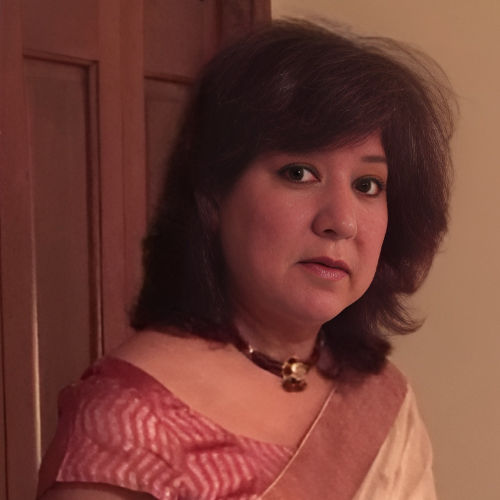
Seema Agrawal
Co-founder
Artisan Saga
We revive traditional designs, handwoven and in pure fabric
Artisan Saga, founded by Kaushik Rajani and Seema Agrawal, is an online store for artisanal handlooms and handcrafted art. The brand handpicks the best from the finest hand and curates classic and traditional handloom sarees in pure fabric reflecting the diverse Indian weaves and styles. Fibre2Fashion spoke to co-founder Seema Agrawal to understand the company's journey and the ebbs and flows of the Indian handloom niche.
Fibre2Fashion: How and when did you start Artisan Saga? Why did you want to work with handlooms?
Seema Agrawal:
F2F: How many weavers do you work with? Do you work with artisans directly?
SA:
We do work with weavers directly. Our weavers come from villages in Benaras, Paithani in Maharashtra, Patola in Gujarat and Maheshwar in Madhya Pradesh. We work with 12-15 master craftsmen. The master craftsman is the head weaver who organises the work, coordinates the process and has many weavers working under him. It is a team work. There is the skilled technician who draws, the weaver who weaves, and so many other tasks that are performed by different people.
F2F: What is the percentage of women workers in the Indian arts and crafts community?
SA:
It is fifty-fifty, as the whole family is involved in weaving.
F2F: Which rare traditional weaves of India are you working to preserve? Can you brief us about some lesser known handloom forms?
SA:
F2F: How do artisans and weavers benefit from working with Artisan Saga?
SA:
They get regular work from us. It keeps their home economics in place. They feel encouraged to expand their work. One of our weavers has now added a special loom to weave cotton for us. Their children who were not interested to join family tradition of weaving are now very much involved with other aspects of weaving, contributing to grow and reach out, and eager to connect with us through Internet.
F2F: Which are the most widely sold handlooms at Artisan Saga?
SA:
Paithanis and single ikat Rajkot patolas are the most sold.
F2F: Tell us about the training process that the local weavers and artisans have to undergo to meet the demand of your customers.
SA:
It is family tradition; the skills are passed on from one generation to the other. Nobody attends a formal training school. They start learning from early years as the whole family is involved in the weaving process, taking turns to weave.
F2F: What new can be expected, be in terms of treatment, colours, design or finishing?
SA:
We are trying to revive old traditional designs in ikats and are working to bring saree designs on dupattas.
F2F: Is the competition in your line of business getting fiercer? How do you cope with that?
SA:
F2F: Please tell us in detail about your latest collection.
SA:
F2F: What is the perception of young India towards handloom?
SA:
Indian youth is still not too aware of the difference between handloom and powerloom. Although there is a movement where sarees are being promoted (through various saree groups online) and saree draping workshops are being held. We see many young girls buying sarees now and wearing them in different styles. But while purchasing, they cannot tell the difference. They tend to get drawn towards cheaper priced textile. Thankfully, awareness towards handloom is increasing due to promotions by us and many others on Instagram and Facebook, exhibitions like Dastkar, Crafts Council of Delhi and saree groups like Six Yards x 365 Days where only handloom wearing, handloom weavers are promoted.
F2F: What needs to be done to keep Indian handlooms more relevant?
SA:
First, to make the items cost effective, the yarn must be made easily available and less expensive. The goods and services tax on the handloom must be removed. More exhibitions should be encouraged and promotions done through special schemes and facilities. The weaving villages must be made easily accessible and their living conditions improved, basic infrastructure and cleanliness should be provided. In schools and colleges, visits to such villages may be organised and workshops arranged to make the youth aware.
F2F: What are the challenges that this niche faces?
SA:
The challenges are to convince the customer to differentiate between handloom and powerloom and to timely source the required number of handloom sarees.
F2F: What kinds of disruptions does this niche need?
SA:
Workshops, write-ups, exhibitions for more awareness and government schemes to generate funds are needed.
F2F: How supportive are government initiatives and schemes towards the Indian handloom community?
SA:
Handloom weavers tell us they hardly benefit. This is an unorganised sector of private individuals carrying on the trade and we do our best to support them. (HO)
Abhay Gupta
Rahul Mehta
Gabi Seligsohn
Anurag Batra
Bill D’Arienzo
Pradip Mehta
Rahul Mehta
Aseem Prakash
Arun Sirdeshmukh
Fanny Vermandel









_8.JPG)



